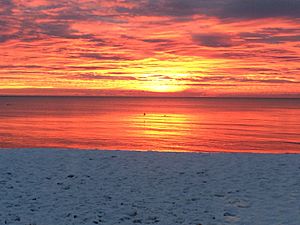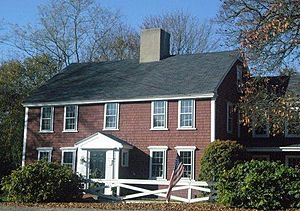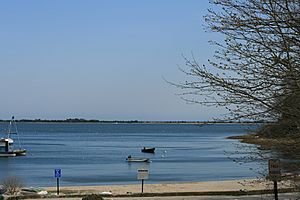Cotuit, Massachusetts facts for kids
Quick facts for kids
Cotuit, Massachusetts
|
|
|---|---|
|
Village
|
|

Location of ZIP code 02635 Cotuit within the Town of Barnstable, county, and state
|
|
| Country | United States |
| State | Massachusetts |
| County | Barnstable |
| Town | Barnstable, MA |
| Area | |
| • Total | 6.60 sq mi (17.10 km2) |
| • Land | 5.50 sq mi (14.25 km2) |
| • Water | 1.10 sq mi (2.85 km2) |
| Population
(1995 estimate)
|
|
| • Total | 3,296 |
| • Density | 599.3/sq mi (231.38/km2) |
| Time zone | UTC-5 (Eastern (EST)) |
| • Summer (DST) | UTC-4 (EDT) |
Cotuit (pronounced kə-TOO-it) is a charming village located on Cape Cod in Massachusetts, United States. It's part of the larger town of Barnstable. Cotuit sits on a small piece of land surrounded by water on three sides. To its west is the Santuit River, to the north are the villages of Marstons Mills, and to the east is Osterville. To the south, it meets Nantucket Sound. Cotuit is mostly a place where people live, and it has several small, pretty beaches like Ropes Beach and Loop Beach.
Contents
Discovering Cotuit's Past
Early Days and the Wampanoag People
Cotuit's story began with a big land deal back in 1648. Myles Standish from the Plymouth Colony bought land from Paupmunnuck, a leader of the Wampanoag people. The Wampanoag village, called Cotachessett, was thought to be near what is now Oyster Harbors. The land was traded for items like kettles and a hoe. This is why a local restaurant is named "The Kettle-Ho"!
The name Cotuit itself comes from the Wampanoag language. It means "place of the council," which suggests it was an important meeting spot. For a long time, Cotuit was known as Cotuit Port, but the "port" was dropped in 1872.
In the early days, people in Cotuit mainly raised cattle and harvested hay from the salt marshes. There were also shipyards in the Little River area, where boats were built.
Historic Homes and Buildings
One of the oldest homes built in Cotuit is the Sampson's Folly-Josiah Sampson House, built around 1793. When Josiah Sampson, an English businessman, built this large house, people thought it was so fancy that they called it "Sampson's Folly." It had many windows and even a ballroom for dancing! Today, it's a private home and is listed on the National Register of Historic Places.
Cotuit in Modern Times
In the early 1900s, Cotuit became a popular spot for tourists, with hotels like The Pines. During World War II, a place called Camp Candoit was located here. In 1987, the Cotuit Historic District was added to the National Register of Historic Places, recognizing its important historical buildings.
Exploring Cotuit's Geography
Cotuit is one of the smaller villages in Barnstable, covering about 5 square miles (13 square kilometers). Most of the village is surrounded by water. Even though it has about 12 miles (19 kilometers) of coastline, the public beaches and water access points are quite small.
The Heart of Cotuit Village
The center of Cotuit is a small, charming area. You'll find a few businesses here, including a restaurant called The Kettle-Ho, the post office, a church, and the Cotuit Public Library. There are also some real estate and insurance offices. Further north on Main Street, there's a small variety store and a grocery store.
Other businesses and cultural spots are located along Route 28 in the Santuit-Newtown area. This is where you'll find the Cotuit Center for the Arts and the Cahoon Museum of American Art. The Cahoon Museum is in the former home of famous American painters, Martha and Ralph Cahoon.
Near the village green, you'll find historic Freedom Hall, used for community events and elections, and Mariners' Hall, which is a Masonic Lodge. The Museum of the Historical Society of Cotuit and Santuit is also nearby, showing what coastal life was like in the 1800s.
The Santuit Area
The northwestern part of Cotuit is known as Santuit. This area is important for its history, with several old buildings like the Crocker House and the Cahoon Museum of Art. The old Santuit Post Office is now a private home, but it still has the original post office boxes.
Cotuit Bay and Its Islands
Cotuit Bay is the main body of water here. It's bordered by Cotuit on the west and Grand Island/Oyster Harbors (part of Osterville) on the east. To the south, you'll find Dead Neck/Sampson's Island. This makes Cotuit Bay a calm and protected harbor.
Sampson's Island is a special bird sanctuary run by the Massachusetts Audubon Society. You can only reach it by boat, and you need a permit to visit. The bay is not very deep and gets busy with boats during the summer. It's also home to the famous Cotuit Oyster Company.
There aren't many commercial boat services directly in Cotuit Bay. You can get fuel in Osterville. Local boatyards help service boats, but there isn't a large marina. A private boat launch service runs from the town dock in warmer months. The town also offers a free pump-out service for boat toilets.
For small boats, there's a concrete ramp at Old Shore Road near Ropes Beach. If you're a resident, you can get a sticker to park your car and trailer there. Cotuit has many public spots to access the water, including Cordwood Landing, Ropes Beach, and Riley's Beach.
Cotuit's Population
Cotuit is one of the less crowded villages in Barnstable. About 2,600 people live here all year round. In the summer, the population grows to about 4,200 people with the arrival of seasonal residents.
The Famous Cotuit Oysters
What Makes Cotuit Oysters Special?
Cotuit Oysters are a special type of eastern oyster found only in Cotuit Bay. They are known for their amazing flavor! Even though wild oysters are slowly coming back, the bay itself hasn't changed much, so the oysters still taste bright and salty, just as they always have.
The Cotuit Oyster Company
The Cotuit Oyster Company has been growing these unique oysters since 1837. It's the oldest oyster brand name in the United States! Cotuit oysters used to be famous worldwide, appearing on menus in big cities like San Francisco and Paris. While their numbers went down in the 1980s, Cotuit Oysters are now making a comeback. You can find them in many nice restaurants on Cape Cod, in Boston, and even at the famous Oyster Bar Restaurant in Grand Central Terminal in New York City.
Fun and Recreation in Cotuit
Sailing Cotuit Skiffs
Cotuit is famous for its unique sailboats called Cotuit Skiffs. These 14-foot (4.3-meter) boats have been sailed on Cotuit Bay for over 100 years! This makes them one of the oldest types of racing sailboats in the world that are still actively used.
The Cotuit Skiffs were designed in the early 1900s. They were based on the flat-bottomed boats used by oyster and clam fishermen. These boats are tricky to sail, especially when it's windy, because they have a very large main sail and no jib. They are usually raced by one or two people.
Since 1906, the Cotuit Mosquito Yacht Club (CMYC) has hosted races during the summer. The club also has a sailing program for kids aged 8 to 18, teaching them how to sail.
The Cotuit Kettleers Baseball Team

The Cotuit Kettleers are a well-known amateur baseball team that plays in the Cape Cod Baseball League. They play their home games at Lowell Park. The Kettleers have won more Cape League championships than any other team! Many players who played for the Kettleers later went on to play in Major League Baseball, including stars like Will Clark, Joe Girardi, and Chase Utley.
Famous People from Cotuit
Cotuit has been home to many interesting and important people over the years. Here are a few:
- Otis Barton and William Beebe: Pioneers who explored the deep ocean.
- Jacques Barzun: A famous writer and critic.
- Matthew Barzun: Served as the U.S. ambassador to the United Kingdom.
- Stanley Cobb: A neurologist, known as a founder of "biological psychiatry" in the U.S.
- Erik Erikson: A well-known developmental psychologist.
- Foster Furcolo: The 60th Governor of Massachusetts.
- Mark Antony De Wolfe Howe: An editor and Pulitzer Prize winner.
- Abbott Lawrence Lowell: A former President of Harvard College.
- Jim Manzi: A former CEO of Lotus Development Corp.
- Frank McCourt: A former owner of the Los Angeles Dodgers baseball team.
- Patrick Robinson: A popular author.
- Dr. Helen B. Taussig: A heart doctor famous for her research on "blue baby" syndrome.




